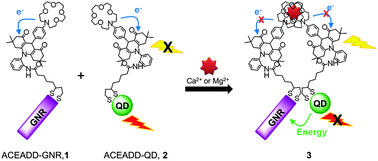Metal ion-induced dual fluorescent change for aza-crown ether acridinedione-functionalized gold nanorods and quantum dots†
Abstract
Aza-crown ether acridinedione-functionalized

* Corresponding authors
a
Department of Chemistry, Pohang University of Science & Technology, Pohang, Republic of Korea
E-mail:
sungjee@postech.ac.kr
Fax: +82-54-279-1498
Tel: +82-54-279-2108
b School of Interdisciplinary Bioscience and Bioengineering, Pohang University of Science & Technology, Pohang, Republic of Korea
c
Samsung Advanced Institute of Technology, Mt. 14-1, Nongseo-Dong, Giheung-Gu, Yongin-Si, Gyeonggi-Do, Republic of Korea
E-mail:
n2010.park@samsung.com
Aza-crown ether acridinedione-functionalized

 Please wait while we load your content...
Something went wrong. Try again?
Please wait while we load your content...
Something went wrong. Try again?
R. Velu, N. Won, J. Kwag, S. Jung, J. Hur, S. Kim and N. Park, New J. Chem., 2012, 36, 1725 DOI: 10.1039/C2NJ40444C
To request permission to reproduce material from this article, please go to the Copyright Clearance Center request page.
If you are an author contributing to an RSC publication, you do not need to request permission provided correct acknowledgement is given.
If you are the author of this article, you do not need to request permission to reproduce figures and diagrams provided correct acknowledgement is given. If you want to reproduce the whole article in a third-party publication (excluding your thesis/dissertation for which permission is not required) please go to the Copyright Clearance Center request page.
Read more about how to correctly acknowledge RSC content.
 Fetching data from CrossRef.
Fetching data from CrossRef.
This may take some time to load.
Loading related content
